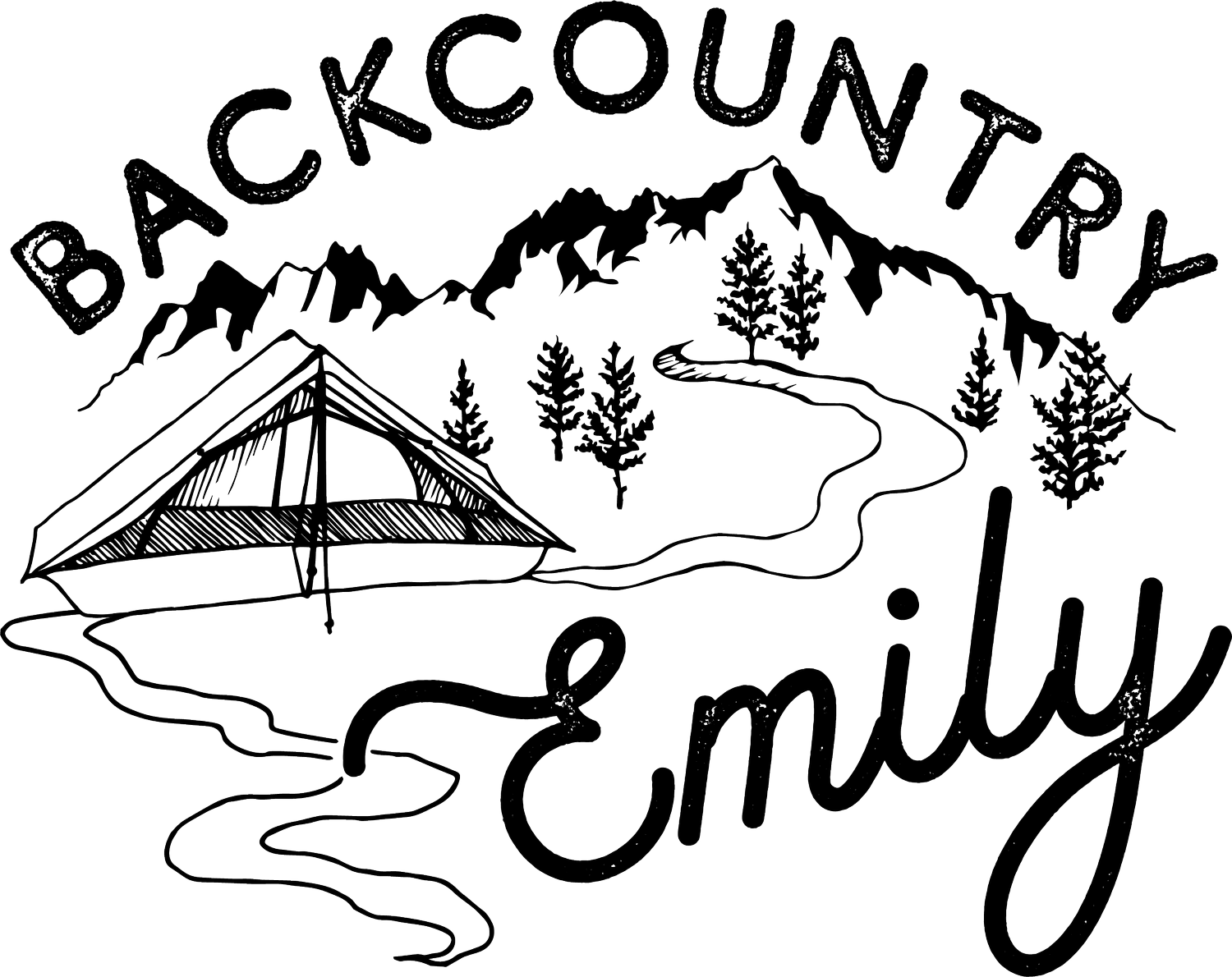How To: Plan and Layer Clothing for the PCT
Since being back home, I’ve returned to my previous job at REI, working on the clothing floor. So, I’ve been inspired to talk about my clothing system on the PCT, since I seem to do that all day anyways! In this post, I will explain a general layering system as it applies to the PCT, and will mention some gear I used. There will be links, which are NOT affiliate links, but many products I received at a discount through work. Also, know that YOU know your body the best. Only you know if you are a cold or hot person, only you know if you would definitely need warmer layers or could forgo sleeping clothes. Knowing this is advance will help, but you can also figure these things out on the trail.
A non-breathable rain jacket traps heat in and keeps you warm
Understanding the Climate of the Pacific Crest Trail
This is such an important point of any discussion of clothing and layering. Climate and weather dictate what you wear. I am going to be discussing the climate and weather that I experienced on my thru-hike in 2018. Generally, this is what the weather is like on a normal PCT thru-hike, which I found out by talking to other thru-hikers in previous years, and by my own experience of having lived on the West Coast my whole life. Obviously, every year is different, but I believe this discussion will be true most of the time. I will also only be talking about weather during your typical thru-hiking season, in the northbound direction. Though, it is my understanding that most of this will apply to a southbound thru-hike as well, but you will probably want my Sierra gear in Washington, and my Washington gear for the Sierra. You should also understand, especially if you aren’t from the west, that fire dictates our outdoor lives. Fire is changing the landscape of the PCT, and the climate is changing our fire season. It is practically guaranteed now that you will experience fire, smoke, and fire closures throughout the trail.
Simply put, the PCT is dry and hot, except for Washington in September and later.
The Desert: In the desert in the springtime (late March-early June), you can experience temperatures up to 100 degrees F, sometimes beyond. The desert is incredibly exposed, without much high tree cover. However, the desert can be windy, and cold in the mornings and at night. Some hikers report that their coldest nights on trail are in the desert, depending on start date. I also experienced rain and snow (twice) in the desert. For those reasons, you should not forgo your insulation and rain layers.
The Sierra: The Sierra in early summer (early June-early July) is generally warm. The nights can be cold, and campsite selection is important to staying warmer at night. It will be colder at night in early June, but by mid-June, it will be warmer, even at elevation. During the day it will be warm-hot. The sun can be intense since you are at a higher elevation. Like the desert, it can be windy on the passes, and it is very exposed. Even when you are below treeline, there aren’t a ton of trees, even though it seems like it because the desert in comparison is really treeless. There is also the risk of afternoon thunderstorms in the Sierra, so a rain jacket will still be very helpful here. The mosquitos can also be pretty horrendous, so you may consider chemically treated clothes and long sleeves/ pants.
When bugs are terrible: Loose, long pants (wind pants here), long sleeves, and a headnet are helpful (Sierra)
Short sleeves and shorts are still my favorite in warm weather when bugs aren’t horrendous (NorCal)
Northern California: By the time you hit NorCal, it is July, and summer is in full swing, especially in this region. It will be hot. I had a week of temps above 100 each day. At night, it seemed like it never went below 60 from Sierra City to Mt. Shasta. The air is stagnant, and can be full of smoke. You will welcome even the slightest breeze.
Oregon: Most hikers will be in Oregon during August. At this point, Southern Oregon will still be pretty warm during the day, but with cool mornings, and nighttime temps will start dropping. By Northern Oregon (Mt. Jefferson area/mid-late August), you may encounter cooler days and cold mornings and evenings. Rain is more likely the closer to September it gets. If you are fast and go through Oregon earlier, it will still feel like summer: hot, dry, mosquitoes. You do have much more tree cover and shade during the day, however.
Washington: Depending on your hike, you’ll be in Washington during August, September, or October. You really should try to finish by the end of September/ first week of October. Snow is likely at higher elevations anytime after mid-September, though unlikely until October. In September, when I went through, I had a little bit of everything in Washington. It was super hot in Southern WA until I got to White Pass, but chilly in the mornings. From White Pass to Steven’s Pass I had cool days with intermittent rain. Temps never really got above 65 after White Pass. Steven’s to Stehekin I had surprisingly beautiful weather: lots of sun, not too cold nights. Stehekin to Canada I had pouring rain, light snow, lots of clouds and fog, and freezing mornings and nights. Washington is probably the most unpredictable during this time, so it is best to be prepared.
Long Sleeve Thermal Hoodie over my SS shirt + Buff over the ears was the perfect amount of warmth for cooler, sunny Washington mornings
Layering System While Hiking
Long Sleeve or Short Sleeve Breathable Top: Most will recommend a LS where the sleeves can be rolled. I will as well, though I did switch to a SS in NorCal and don’t regret it. Just make sure to wear sunscreen. If you are fair-skinned, you should wear a LS top the whole trail.
My Pick: REI Sahara
Long, breathable, quick-drying pants or Running shorts: Like your top, this is personal preference. I wore shorts for the whole trail and personally would have been too hot & sweaty for pants. I always have issues with pants not fitting my body well: leggings, pants, etc. never fit my thighs great, always ride down, which results in uncomfortable sweat and chafe near my crotch and upper thighs (sorry for the visual, but its the truth and something to consider).
My Pick: Patagonia Strider Shorts
When you are cold: Wind or Rain jacket for your top; wind or rain pants for your legs. I would do the rain jacket/ wind pants combo for the desert & Sierra, rain jacket/ rain pants combo for Washington. I wouldn’t carry either in Northern CA, and I’d carry a rain jacket in OR. Based on the weather I experienced. To be safe though, you’ll probably want to carry a rain jacket in NorCal. I also added the Patagonia Capilene Thermal Hoodie in Washington, which became an extra hiking layer for me, so I could have warmth without having to wear my rain jacket since it was cold most of the day. This “extra layer” could also have been a heavier fleece or other synthetic jacket (like a Melanzana or Montbell Thermawrap) that could have also replaced my down jacket, if I wanted to be very weight conscious and reduce redundancies. You could add in your insulating layer here, but I personally don’t like to hike in a down layer because I heat up too fast. You may prefer to hike in your insulating layer.
My Picks: Outdoor Research Helium II Jacket, Outdoor Research Helium Pants, Patagonia Capilene Thermal Weight Hoodie
When you are cold (accessories): I did not feel the need for these in any other section besides Washington, but I also get hot fast when I’m moving. Other people may be more cold. Thin liner gloves, lightweight rain mitts, and a balaclava are great, versatile accessories that are super light and will help with warmth.
My Picks: Montbell LW Gloves, Montbell UL Shell Mittens, Montbell LW Balaclava
Sun Protection: Hat (wide-brimmed is best), Sunglasses, Sun Gloves, Umbrella. This is mostly a concern for California. I ditched all of these by Oregon, except for sunglasses.
Other Clothing: Underwear - choose something that wicks fast and has good odor control. Bra - ladies, you probably know what you like. Again, choose something that wicks sweat well. Buff - I liked to wear this over my ears when it was cold. Socks - I like Injinji midnight merino because they wick sweat, promote natural toe splay and prevent in-between toe blisters.
My Picks: Icebreaker Siren Bikini Underwear, Injinji Socks, My Patagonia Active Mesh Bra has been discontinued, and I can’t recommend the new version bc I hate it.
When its freezing and you’re hiking, put on ALL of your layers (I leave out the down jacket, and sleeping base layers though)
Layering System While Sleeping
Base Layer Top*: I used a lightweight synthetic top. It was sufficient for the whole trail. LW merino wool would be a good option as well.
My Pick: Patagonia Capilene Lightweight
Base Layer Bottom*: I used a lightweight synthetic bottom. It was sufficient for the whole trail. LW merino wool would be a good option as well.
My Pick: Patagonia Capilene Lightweight
Sleep Socks: UL people may debate their necessity, and I only wore them a handful of times on the whole trail, but they will be important in the Sierra and Washington, or if your sleeping bag isn’t very warm, or if you have Reynaud’s Syndrome. They should probably be a mid-heavy weight material, preferably merino wool. Some people also use down socks/ booties if they have severe circulation issues. Remember, they are part of your defense system in the case of hypothermia.
My Pick: Darn Tough Hiker Micro Crew
Insulating Layer: Whichever you choose, down or synthetic, you’ll need something to keep you warm while you are sitting around at camp or during breaks. The PCT is dry enough where down is a fine choice for insulation.
When you are cold: Put on all of your layers when sleeping. See above.
*Some hikers will forgo sleep clothes, and that is totally fine. I preferred to sleep in “cleaner”, dry clothes. I’d probably recommend having them for Washington though, especially if the forecast calls for rain & snow.
I only needed to wear my down jacket while sleeping 3-4 times on the whole trail, mostly in the desert, and on my last night on trail. A buff can be transformed into a balaclava in a pinch too.
I hope that was helpful! Of course, this is entirely my opinion, and what worked well for me on my hike. I’ve hiked in a variety of different conditions wearing different clothes, and my system for the PCT was by far the best I’ve used to date. As always, let me know if you have any questions, as I would be happy to help out!







